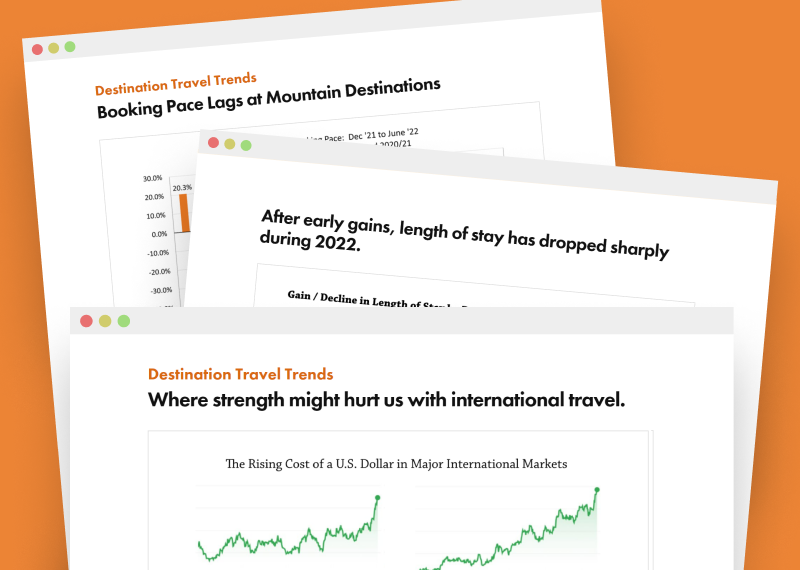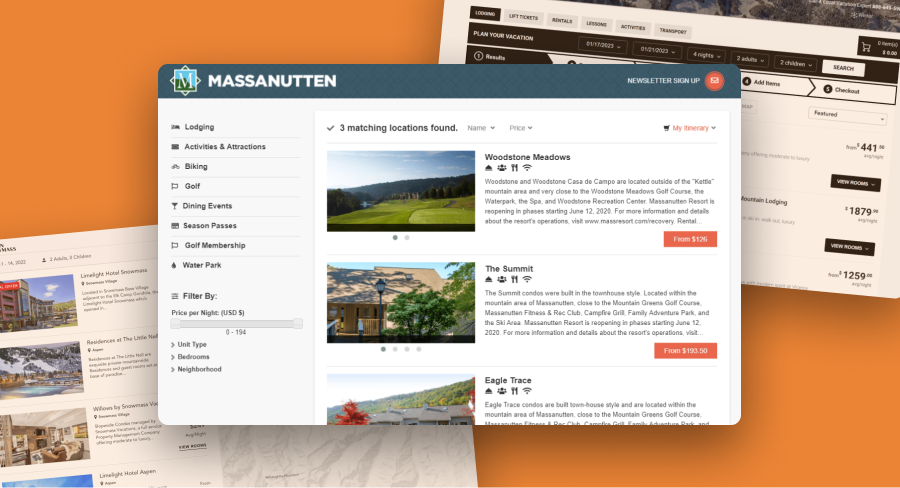
While resorts need a way to sell their products just like a hotel booking engine or other travel destination, resorts are selling much more dynamic itineraries than a standalone hotel ever will. Yes, resorts offer somewhere to sleep, but they also offer the reasons someone might need a place to sleep in the first place. This may include lift tickets to a ski area, tee-times to golf courses, tickets to a waterpark or amusement park, bike rentals, kayak rentals, shooting range access, or lessons for more skill-based activities.
When you’re selling so many activities, it’s common for resorts to want a purpose-built system to manage the inventory and reservations for each activity. This means that resorts will often sell lodging through one booking engine, tickets or activities through another booking engine, rentals through yet another booking engine and so on. Over the years, this has led to a very siloed booking experience for the guest where they’re juggling multiple transactions, multiple receipts, multiple confirmation numbers, and entering the same dates and details into each one.
This is where a resort booking engine comes into play. In this guide we’ll answer three questions about resort booking engines:
- What is a resort booking engine?
- How does a resort booking engine work?
- What are the benefits of a resort booking engine?
Let’s dig in.

A multi-system booking engine is ideal for resorts because they can sell real-time availability from multiple systems in one booking engine.
#1) What is a resort booking engine?
A resort booking engine like Inntopia Commerce is more than just an ecommerce tool for the inventory that exists within an individual system. A resort booking engine allows guests to book live inventory from multiple systems in a single interface. Multi-product bookings come with various expectations for different types of guests. For example, a recent survey we did of 350 travelers showed that about half of guests prefer to book asynchronously – booking either lodging or activities first and then coming back later to book the rest – while the other half prefer to book everything at one time either in a package or choosing each item a la carte.
A resort booking engine works with these guest’s unique preferences to allow them to book all of these items through the same online booking engine no matter when or where they want to book each piece. Even more, a booking engine should allow your call center to do the same and allow a layer of human help for guests who either want to shop online but book over the phone or guests who want to build their itinerary with the help of an agent but then review it with their partner before booking.
A resort booking engine will allow the guest to book everything they need for a vacation in a single, cohesive place. It will also allow a resort’s call center and service team to properly support them as they do.
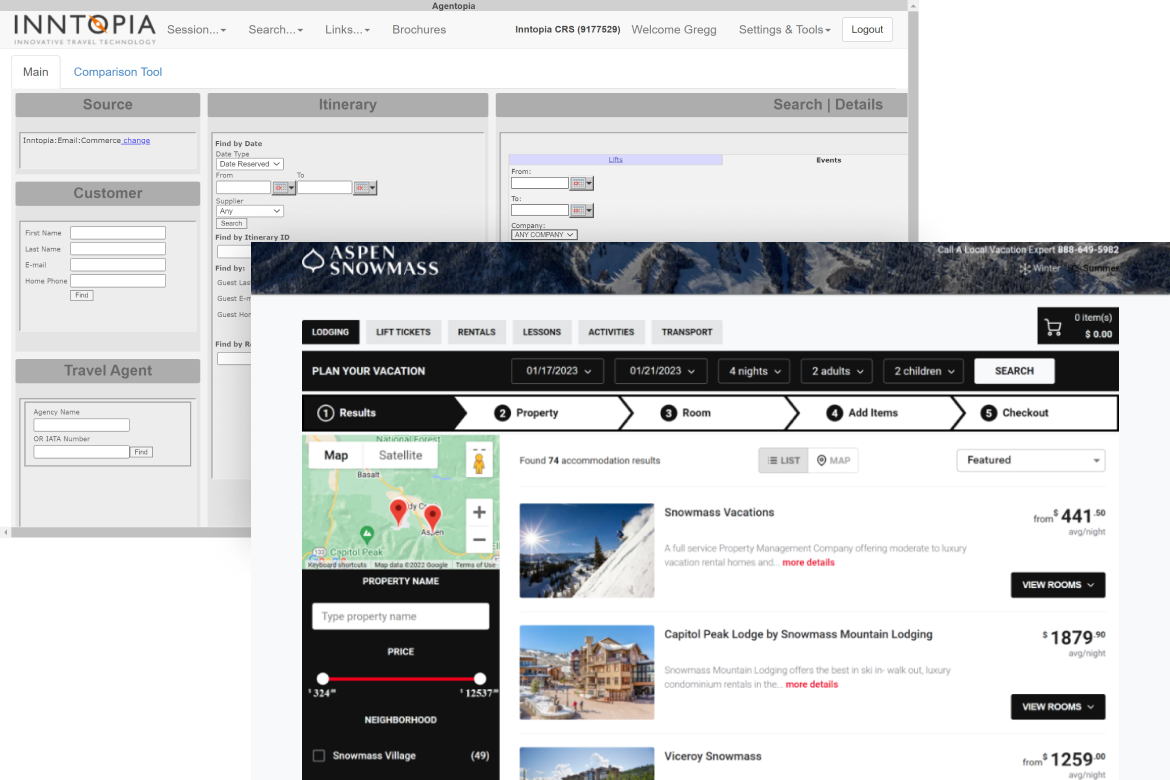
A resort booking engine call sell inventory from multiple systems in one interface both online and over the phone.
#2) How does a resort booking engine work?
As we mentioned above, a resort booking engine allows a guest to book live inventory from multiple systems in a single place. Booking engine software may be purchased by resorts and hoteliers with a commission-free subscription model or a transactional model with lower up-front fees. To do this, a resort booking engine will:
- Aggregate inventory from multiple systems
- Apply business and packaging rules
- Display real-time availability in an online interface
- Process everything in a single transaction
- Push details back to source systems
Let’s dig into each of these elements individually.
Aggregate inventory from multiple systems
A resort booking engine starts by establishing a real-time, two-way connection with every system that is storing inventory your guests need to book. This could be the PMS of hotels, B&Bs, or vacation rental properties you own, the POS you use for bike rentals, the reservation software in your spa, or the PMS of a lodging partner whose rooms your guests may want or need to book. All the key details for the products in each system can be accessed by the booking engine in real time.
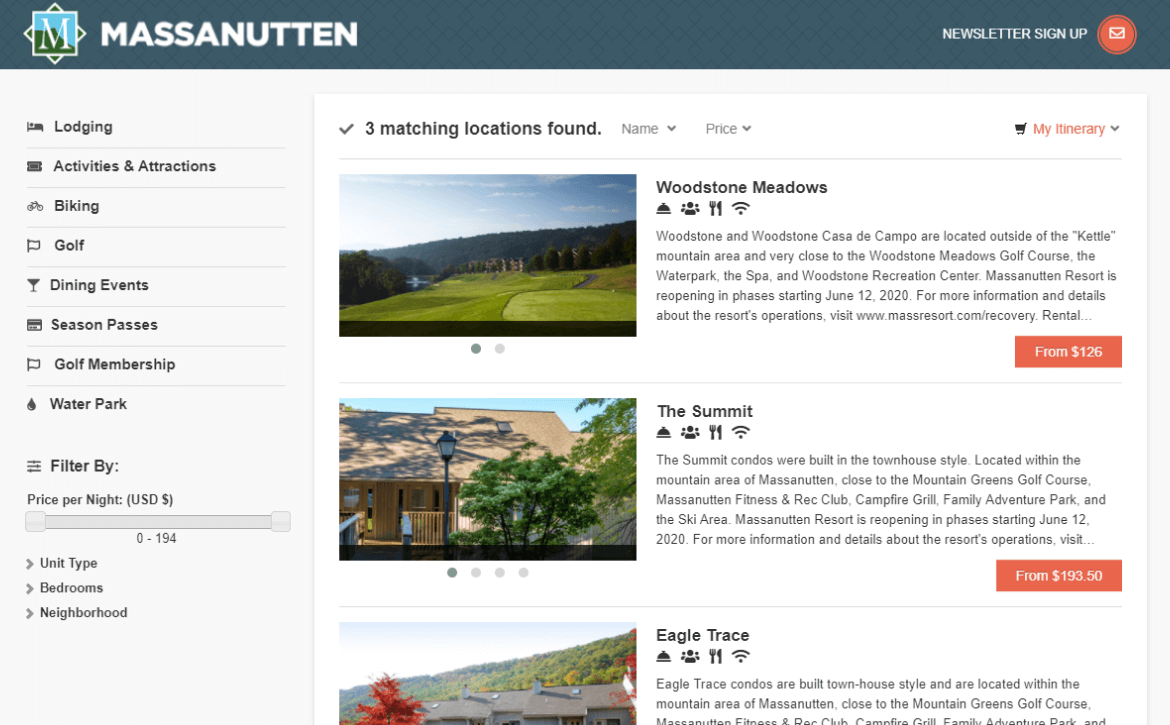
Massanutten sells nearly a dozen product types, but all can be offered from the same resort booking engine.
Management software to apply business and packaging rules
Once you have access to all the inventory in those systems, an online booking engine will allow you to organize these products, apply business rules to them, and get them ready to sell. This would include restrictions on which products can be sold together, minimums required for various products or product combinations, predetermined packages your guests can book, and other rules, combinations, pricing settings that allow you to ensure products are sold in the ways your team, systems, and workflows require.
Display real-time availability in an online interface
Next is the traditional, visible part of a the online reservations system you may be familiar with: the actual ecommerce interface. This user-friendly booking experience will allow your guests to search live rates, room types, availability, and inventory across all of your systems in a single place. The online reservation system will allow them to add individual items to their cart, build custom itineraries, and choose specific items within a package. Your resort booking engine should also allow your call center to do the same thing from an interface designed for agents. Even more, it should allow a guest to move back and forth between your call center and your website without having to start over.
For example, a guest may want to build their itinerary during the evening with their family but they call an agent to review that itinerary and be sure they got everything right. Or, they may want to work with an agent to build an itinerary before reviewing it with their spouse in the evening and booking online. Or perhaps your call center is simply playing the role of customer support by looking up past itineraries. A resort booking engine should allow your guests a user experience that matches their preference.
Process everything in a single transaction
As we just alluded to, a online booking engine will not just allow your guests to build an itinerary with live inventory pulled from all of your systems but actually pull out their credit card and book that itinerary as well. When they do this, they will receive a single receipt itemizing all of the parts of their itinerary and a single charge on their credit card. This is possible because a resort booking platform will integrate with your payment gateway to handle all the payment processing directly in the software. To the guest it will appear as if they booked everything from a single system even though their itinerary is made up of products pulled from multiple PMS, POS, and other systems.
Push reservation details back to source systems
Finally, the resort booking engine will use real-time automation to push all of the details for each product that was booked back into each original system as if it was booked there in the first place. For example, the rate, dates, guests, and add-ons that came from the property management system will be synced back to the PMS so the reservation is visible as if it had been sold directly out of that system in the first place. Likewise for, say, a tee-time that was included in that same itinerary. The tee-time, rate, date, and group size will be synced by the resort booking engine back into the tee-sheet program as if the pro shop had taken the reservation directly. This allows your guests to check-in like normal as if they’d booked their vacation directly with the front desk, call center, or PMS.
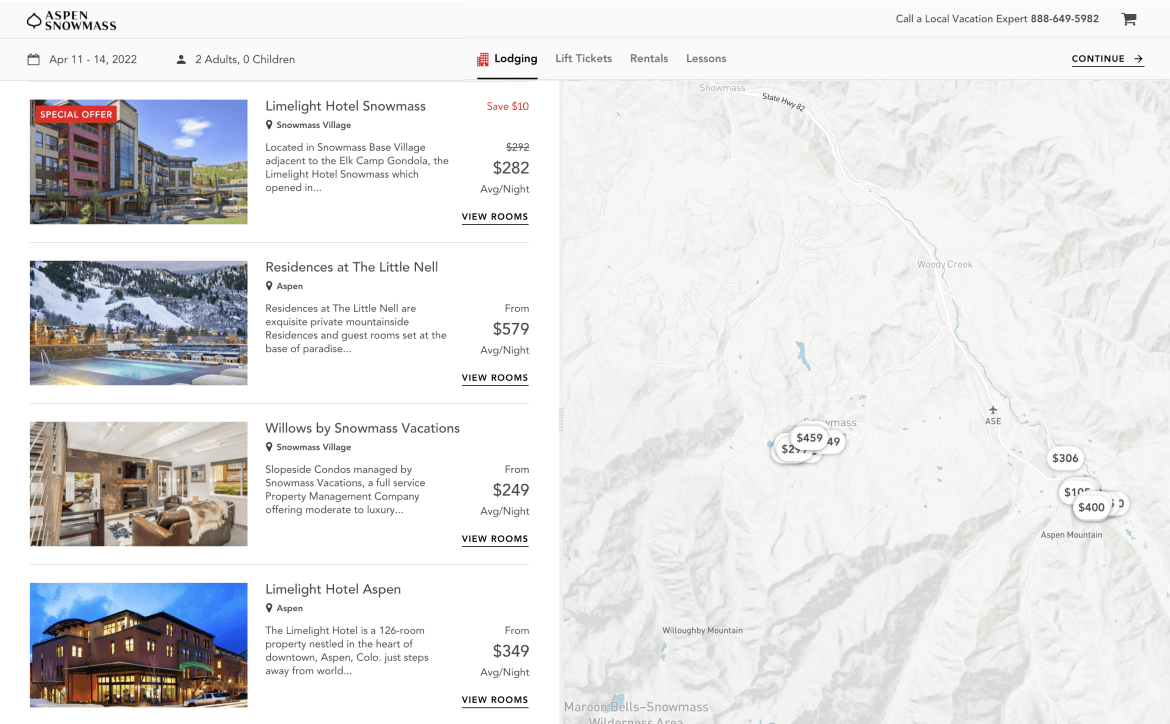
Once guests book their itinerary, details flow back into each original source system.
#3) What are the benefits of resort booking engine?
A resort booking engine implies who needs it – resorts – but let’s get more specific because some hotels and even activity providers act as full resorts even though they technically only sell one part of the experience. For example, a hotel down the road from a ski resort is selling a ski vacation even if they are only fulfilling the lodging portion of that guest’s experience. In the case of resort booking engines, three primary needs make a property a prime candidate for needing a resort booking engine: the reason guests visit and the number of products they need to book if they do, and you want to offer your guest a less confusing booking experience.
The Reason Guests Visit
First, a resort booking engine is ideal when a guest is looking for an experience rather than just a place to sleep. An airport hotel probably doesn’t need a resort booking engine as much as a beach hotel. This implies a handful of other variables, but the most important is the number of things that guest is hoping to experience during their stay.
The Number of Products Guests Need
If the majority of your guests need to book more than one product when they visit your destination, you need a resort booking engine. Let’s say a typical guest books at least a hotel room and lift tickets. Whether you own both the ski lifts and the hotel, just the hotel, or just the ski lifts, a resort booking engine will allow you to sell both products side-by-side.
Less Confusing Booking Experience
Most importantly, a resort booking engine allows all of your different guests to book exactly what they need in one place. This is better for the guest because they get a single booking confirmation and only have to interact with and log in to a single system. And this is better for the resort because this centralized, simplified booking experience will lead to larger itinerary sizes, higher conversion rates, and more satisfied guests.
Many Other Benefits
The more significant benefits of resort booking engine functionality are an increase in direct bookings which decreases your reliance on online travel agencies (OTAs) and increasing direct revenue. If OTAs are a priority, some resort CRMs will also include some level of channel management to allow inventory to be distributed to sites like Booking.com and AirBnb,
Either way, resort booking engines like Inntopia Commerce offer a booking experience that gives the resort a chance to increase direct bookings if needed. And that is a direct result of offering the guest a reservation system that is built specifically for the guest experience and making it as easy as possible for them to book. The guest gets a better experience, your resort gets more revenue and occupancy, and the effect of this booking process snowballs as the guest has a great experience which increases the likelihood that they’ll book again.
Resort booking engines and packaging options.
We could have talked about this as a perk of using a resort-specific booking engine, but it’s worth a mention separately because it’s a really key point. Traditionally, resorts have used pre-determined packages to let guests book multiple products that exist in various systems. A resort booking engine does this as well, but it does it dynamically. Let me give you a few examples of guest behavior and how it would work in both types of booking engines.

A resort booking engine’s packaging options give multi-system resorts lots of flexibility and time savings.
Guest looking for a pre-built package.
The guest probably doesn’t have specific needs and is okay with whatever packages exist as is. In this case, the booking experience for the guest is similar between a normal booking engine and resort booking engine. But for your team behind the scenes, fulfillment with the traditional booking engine may still require manual entry of the package components into those other systems while a resort booking engine will handle that automatically.
Guest looking for a customized package.
With many traditional booking engines, this is impossible because you can’t be sure that the inventory they want in place of the package’s defaults is available. In a resort booking engine, this can be easily set up as an option within the packages settings so if a guest wants a different room, different tee-time, different spa package, etc. they can easily swag it out.
Guest looking for a totally unique package of products.
With a traditional booking engine, the only way for the guest to do this would be to manually browse multiple booking engines, make sure their dates are all consistent across each one, enter their credit card multiple times, and get multiple receipts. With a resort booking engine, they can easily book one product type, browse for another product type and add that to their cart, browse another type and add that to their cart as well, then check out once and get one receipt.
Some resorts dream of selling everything in one booking engine but don’t realize this is possible. If you’re in that group, give Inntopia Commerce a look.
Have a question? Just ask.

Tyler Maynard
SVP of Business Development
Ski / Golf / Destination Research
Schedule a Call with Tyler→

Doug Kellogg
Director of Business Development
Hospitality / Attractions
Schedule a Call with Doug→
If you're a current Inntopia customer, contact support directly for the quickest response →
Request Demo
A member of our team will get back to you ASAP to schedule a convenient time.


